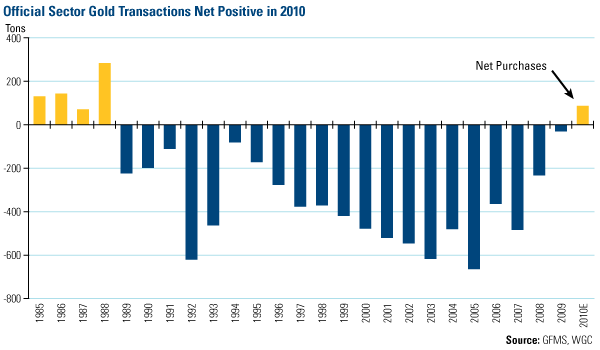Q. How are interest rates currently affecting commodity prices?
A. The magic number for real interest rates is 2 percent. That’s when you can earn more than 2 percent on a U.S. Treasury bill after discounting for inflation. Our research has shown that commodities tend to perform well when rates fall below 2 percent.
Take gold and silver, for example. You can see from this chart that gold and silver have historically appreciated when the real interest rate dips below 2 percent. Additionally, the lower real interest rates drop, the stronger the returns tend to be for gold. On the other hand, once real interest rates rise above the 2 percent mark, you start to see negative year-over-year returns for both gold and silver.
Whether you are Republican, Democrat, Independent or Agnostic, it’s important to realize that it’s not about politics, but about policies. During the 1990s when President Clinton was in office, there was a budget surplus and investors could earn more on Treasury bills (about 3 percent) than the inflationary rate (about 2). This gave investors little incentive to embrace commodities such as gold, and prices hovered around 0 an ounce. Now under President Obama, there is a large budget deficit and we have negative real interest rates, and gold is in great demand.
Interest rates in the U.S. have been near zero since 2008 and we don’t see the Federal Reserve increasing them until at least 2012. The U.S. economy remains in intensive care: Stimulus efforts have been unable to stimulate significant job growth and unemployment remains near 10 percent. In addition, the existing home sales figures released last week reminded everyone that housing is still on life support.
Even though there has been a lot of talk about reducing deficit spending and the U.S. House of Representatives voted against raising the debt ceiling this week, we don’t see any desire from the Federal Reserve to raise interest rates. The government realizes it is extremely dangerous to pull back the reins right now.
Q. How do the financial troubles of European countries such as Greece and Portugal affect gold prices?
A. The market has definitely been more volatile as some of the financial problems started to pop up again in Europe. The re-emergence of these issues is just another example of how many developed economies around the world are overleveraged and heavily burdened by their debt.
Some of the weaker countries, particularly Greece, could end up ditching the euro as their main currency. This would obviously be a destabilizing event for the euro and would result in some short-term strength for the U.S. dollar, thus providing a headwind for commodities. However, the U.S. dollar is plagued by the same problems as the eurozone; i.e., a weak economy and higher unemployment.
Meanwhile, central bankers in emerging markets have excess reserves and are looking for ways to diversify away from these paper currencies. To protect themselves from paper currency devaluation many of them have turned to gold. Last year was the first net positive year for central banks’ buying of gold since 1985. They’ve chosen to own gold over trying to guess whether Portugal or Greece’s debt is the best investment.
This isn’t a completely new phenomenon. Russia announced that it was going to diversify roughly 5 percent of its reserves into gold back in 2005 when gold prices were at 0 an ounce. The tipping point came in 2009 when India purchased 200 tons of gold from the International Monetary Fund (IMF), which effectively set a floor under gold prices at ,000.
Since then, we’ve seen countries such as Thailand, Bangladesh, Vietnam, Venezuela and the Philippines add to their official gold reserves. Earlier this year, Mexico purchased 100 tons of gold to boost its reserve holdings.
This trend should continue.
Q. With oil prices hovering around 0 per barrel, what is the outlook for oil prices for the next two to five years?
A. We remain bullish on crude oil for one simple, fundamental reason: Demand is greater than supply. We don’t see that changing in the foreseeable future.
One big driver is a rapidly growing demand for cars and automobiles in emerging markets (Read: Booming Global Auto Market Good for Many). There’s also rising demand for oil due to urbanization and rising per capita incomes in emerging economies. As their economies grow and their populations become more prosperous, they want and can afford to upgrade infrastructure and other construction projects which require oil to be produced (Read: Why Asia is the Epicenter of Oil Demand Growth).
However, it is important to manage expectations. As the price of gasoline rises and inflation fears grow, countries such as India have been forced to lower government fuel subsidies. This will cause some demand destruction as consumers adjust to paying more at the pump, a situation not very different from what we’ve seen recently in the U.S. Though it has the potential to spread if inflation gets out of control, we think this dip in demand will only be temporary.
On the supply side, it’s getting more difficult to find new supply and even when large reserves are discovered, they lie deep beneath the ocean floor or in parts of the world where it’s dangerous to operate (Read: Why High Oil Prices Are Likely Here to Stay).
We think these trends appear to be firmly intact and are why we remain constructive on crude oil prices over the next several years.
Foreign and emerging market investing involves special risks such as currency fluctuation and less public disclosure, as well as economic and political risk. Because the Global Resources Fund concentrates its investments in a specific industry, the fund may be subject to greater risks and fluctuations than a portfolio representing a broader range of industries.
All opinions expressed and data provided are subject to change without notice. Some of these opinions may not be appropriate to every investor.








